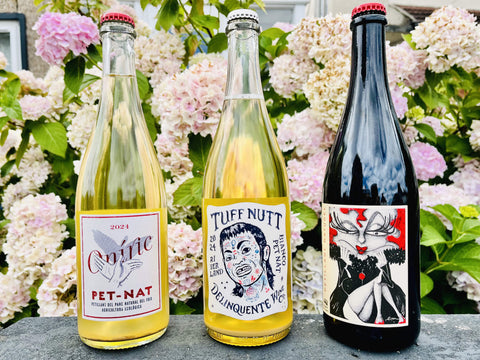When it comes to natural wine, few people consider sparkling wine as part of the movement. Yet sparkling wines are experiencing one of the most defining revolutions: Pet Nat wines.
Pet Nat comes from the French pétillant naturel, meaning "naturally sparkling." You can find them in white, rosé, and red varieties. Often lower in alcohol and full of fruit with a gentle fizz and just the right amount of funk, they're the perfect bottles to pack for a picnic in the park on sunny days or to bring to the table for end-of-year celebrations to surprise the whole family.
In this guide, we'll take you through the process of making these naturally sparkling wines, explore their roots in natural winemaking, explain what to expect when tasting Pet Nat wines, discuss how to pair them, and share a selection of our favourite bottles.

What is Pet Nat? The Ancient Method Made Modern
Most of your favourite bottles of fizz, such as Champagne or Cremant, bear the mention méthode traditionnelle or méthode Champenoise, referring to the traditional method used in making great Champagne. This protected method involves a two-step fermentation process, with the second fermentation occurring in the bottle after the addition of sugar and yeast.
The méthode ancestrale, or ancestral method, used in Pet Nats, however, requires only a single fermentation. The wine is bottled while it's still fermenting, relying on residual grape sugars for carbonation. And while Pet Nat wines have the reputation of being a new "trend" alongside the natural wine movement, they actually rely on the oldest way of making sparkling wine.
This pattern is quite common in modern wine. When orange wine came into the picture, it was also portrayed as very experimental and unusual, when in fact it was the oldest known method of making white wines, still used in countries like Georgia and Greece.
Pet Nat is, in fact, not a new type of sparkling wine, but rather a return to the ancestral origins of winemaking.
The Pet Nat production process: Why it's considered the most natural Sparkling wine method
The Pet Nat production process takes a "let the wine do its own thing" approach. Because of its close ties to the natural world and sustainability movements, you're more likely to find grapes produced using organic or biodynamic farming methods.
The process itself, relying on sugar residues, requires no dosage, filtration, or sugar addition to kick-start secondary fermentation. It's most likely free from added sulphites, and unlike traditional winemaking methods, the goal isn't to stabilise the wine in bottles but instead to let it ferment naturally. Natural or indigenous yeasts present on the grape skins and in the winery environment will then play a crucial role in the fermentation process.
Because the wine is not disgorged to remove any sediment or lees remaining afterward, it will often present heavy sediment at the bottom of bottles and a slightly cloudy appearance. While this might not be pleasant for the traditional wine drinkers, it's the key to the exciting flavours that come from the ancestral method. It's in this residual sugar, which may not have fermented completely, that the wine releases fresh, fruity flavours without the need for ageing.
Beyond flavours, Pet Nat wines are also having a moment thanks to their lower alcohol content than other sparkling wines—often around 9.5%-12%—made possible through their single fermentation, whereas the secondary fermentation process in other sparkling wine techniques generally raises alcohol content.
The difference between Pet Nats and Sparkling wines like Champagne or Prosecco
Unlike Champagne (using the traditional method) or Prosecco (using the tank method), the main difference between these well-known sparkling wines and Pet Nats comes from the production process of using the single fermentation method.
On a tasting profile, this gives Pet Nat wines lower alcohol content and less acidity, creating more fruit-forward wines with a gentle fizz rather than a full-on sparkling texture.
And because these wines are made to evolve in the bottle, each bottle has its own uniqueness. Compared to a stable Prosecco or Cava, where you know exactly what you're getting, Pet Nats can be more surprising and have a bit more funk, which fits perfectly with wine drinkers who are more adventurous and want to try something different.
If your concerns about wine purchasing stem from sustainability, buying Pet Nat wines is a sure way to get a bottle that has been crafted following climate-friendly and sustainable farming methods with no or low interventions.
Where to find Pet Nat wines
Not sure where to find Pet Nat wines? Visit specialised natural wine shops like Forest Wines. You can find a great variety of white, rosé, and red Pet Nat wines in our East London store or online for delivery across the UK.
You can easily spot a pétillant naturel through their use of crown caps rather than traditional cork and wire cages. This is for several reasons: having been through only a single fermentation, Pet Nat wines generally have a lower pressure environment that doesn't require as strong a seal as Cava and Champagne. Plus, it's more cost-effective. When it comes to the cost of making Prosecco versus Pet Nat, these natural alternatives often make Pet Nat wines more expensive, so any cost-effective way to reduce the price through packaging makes Pet Nat more affordable.
What to expect when tasting Pet Nat
Pet Nat wines offer a unique tasting experience that differs significantly from traditional sparkling wines. Expect bright, fresh flavours with a lively but gentle effervescence. The cloudy appearance and natural sediment are part of the charm, they contribute to the wine's complex, sometimes funky character that natural wine enthusiasts love.
The lower alcohol content makes these wines incredibly food-friendly and perfect for extended drinking sessions. Their fresh, fruity profiles make them versatile for various occasions, from casual gatherings to more formal celebrations.
Food pairing ideas
Pet Nat's versatility makes it excellent with a wide range of foods. The bright acidity and gentle bubbles complement everything from fresh seafood and light salads to charcuterie and soft cheeses. The natural funkiness pairs beautifully with fermented foods, while the fruit-forward character works wonderfully with seasonal produce.
For summer gatherings, try Pet Nat with grilled vegetables, fresh berries, or light pasta dishes. In cooler months, it pairs surprisingly well with roasted root vegetables and hearty grain bowls.

Our favourite Pet Nat wines selection
Interested in tasting your first Pet Nat wine or looking to explore deeper into our selection? Here's a list of our favourite Pet Nat wines that we sell at Forest Wines.
White Pet Nat wines
Chateau Tour Des Gendres, Albert de Conti – Bergerac, France
A bright and refreshing organic Pet Nat from Bergerac, this blend of Chenin Blanc and Sauvignon Blanc delivers tart orchard fruit with underripe white peach notes that balance its gentle sweetness. The finish is bone dry with lovely clean minerality, making it the perfect aperitif-style fizz for those who love crisp, mineral-driven wines.
Pairs with: Fresh oysters, sushi, goat cheese salads, or simply as an aperitif.
Entre Vinyes Oniric Pet Nat – Catalonia, Spain
Fresh and aromatic, this white Pet Nat from Penedes has lovely texture and structure to ground the lively profile. Made from Xarel-lo and Muscat, it's summery and dry with floral notes from the Muscat in the mix, offering light body, peachy texture and that lovely orange blossom perfume at just 11% alcohol.
Pairs with: Grilled seafood, Mediterranean salads, soft cheeses, or picnic spreads.
Tuff Nutt Pet Nat, Delinquente Wine Co. – Riverland, South Australia
A playful and energetic Pet Nat from Australia's natural wine rebels, this cloudy charmer delivers bright citrus and stone fruit flavours with a wild, untamed character. Made with minimal intervention and maximum personality, it's funky, fresh, and unapologetically natural, perfect for adventurous wine lovers seeking something different.
Pairs with: Spicy Asian cuisine, barbecue, aged hard cheeses, or drinking straight from the bottle.
Red Pet Nat wines
Domaine Le Roc Roc'Ambulle Pet-Nat Negrette – Fronton, France
A rare red Pet Nat made from the indigenous Negrette grape, this unique sparkling offers juicy red berry flavours with herbal complexity and a gentle sparkle. From the heart of Fronton, it showcases the rustic charm of southwestern France with vibrant acidity and earthy undertones that make it utterly distinctive.
Pairs with: Charcuterie boards, grilled vegetables, duck confit, or cassoulet.
Pet Nat Renegado, Folias de Baco, 'Uivo' – Douro, Portugal
A wild and expressive Pet Nat from Portugal's Douro Valley, this "renegade" sparkling captures the untamed spirit of the region's steep terraces. With bright acidity, mineral tension, and an intriguing blend of fruit and funk, it's a bottle that tells the story of Portugal's exciting natural wine movement.
Pairs with: Grilled sardines, Portuguese cheeses, roasted peppers, or traditional petiscos.
Rosé Pet Nat wines
Mother Rock Force Celeste Pinotage Pet Nat – Swartland, South Africa
A joyful rosé pet nat made primarily from Pinotage with a splash of Chenin Blanc from the Swartland. This hazy salmon-pink Pet Nat showcases South Africa's signature grape beautifully, with superb aromatics of dark berries, blood orange, and earthy rhubarb. Fresh with crunchy cranberry and raspberry notes, plus the rich, smoky character that makes Pinotage so distinctive.
Pairs with: Bunny chow, grilled lamb, spicy Cape Malay dishes, or braai favourites.
Maupertuis Pet Nat Pink Bulles – Auvergne, France
A delicate rosé Pet Nat from the volcanic soils of Auvergne, this pink sparkling wine offers gentle strawberry and raspberry notes with a lovely mineral backbone. Light, refreshing, and elegantly structured, it brings a unique experience of sparkling rosé wine, produced in a region more known for their cheese than their winemaking.
Pairs with: Summer salads, fresh berries, light seafood, or sunset aperitifs.
Orange Pet Nat wines
Uivo Pet Nat Curtido, Folias de Baco – Douro, Portugal
A scrumptious bottle of fizz that's essentially adult peach iced tea. Made from 100% Moscatel Galego with two weeks of skin contact, this unfiltered orange Pet Nat delivers juicy stone fruit flavours with notes of tangerine, peach, apricot, and white flowers. At just 10% ABV, it's refreshingly lean with zesty acidity, herbal complexity, and a touch of salinity that makes it utterly compelling.
Pairs with: Charcuterie boards, grilled vegetables, light pasta dishes, or tacos.
Conclusion
Pet Nat wines represent the perfect intersection of ancient winemaking wisdom and modern natural wine philosophy. Their unique production method, sustainable approach, and distinctive character make them an exciting addition to any wine lover's repertoire. Whether you're new to natural wine or a seasoned enthusiast, Pet Nat offers a refreshing alternative to traditional sparkling wines.
Visit Forest Wines in East London or browse our online selection to discover your next favourite Pet Nat. With their approachable style, lower alcohol content, and food-friendly nature, these naturally sparkling wines are perfect for any occasion that calls for celebration, or simply the joy of discovering something beautifully different.
Explore our Pet Nat wines here. Looking for more? Here's our full sparkling wine selection.


